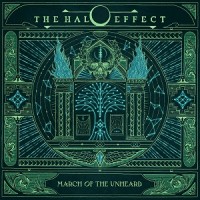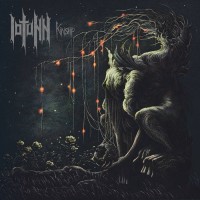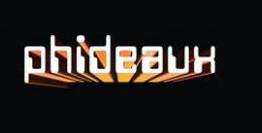Phideaux - Biography
Logo
1996-
Biography
Phideaux Xavier is a composer of modern technological music that he describes as "psychedelic progressive gothic rock," who grew up in New York City but now lives in Los Angeles. He is also one of the directors of the popular soap opera Passions.
Phideaux was born and raised outside of New York City in a town called Hastings-on-Hudson, one of three children. He started composing music in high school, performing in bands known as Sally Dick & Jane, Neck Tie Party, The SunMachine, and Satyricon (not to be confused with Norwegian band).
Phideaux released a number of recorded tracks on cassettes for his friends in his early years, and then later, in 1992, produced a small number of copies of a CD entitled "Friction." Although it did not get to many people, a few CD reviewers were able to get copies of it and hear it.
Later, in 2002, Phideaux started seriously mastering musical tracks and, in 2003, released his first recent CD, "Fiendish." The year 2004 saw his much-improved "Ghost Story", which was followed up quickly in 2005 by a third album, "Chupacabras," and then a fourth album, "313," in March of 2006, and his fifth album, "The Great Leap," in September of 2006. He is currently(September/October 2006) working on the second part of a trilogy of albums that begins with "The Great Leap."
The performers who work with Phideaux, with the exception of drummer Rich Hutchins, are people that he grew up with. They have played together in various incarnations for many years. Producer Gabriel Moffat and keyboard player Mark Sherkus compliment a lineup that includes vocalists Molly Ruttan, Linda Ruttan-Moldawsky, Ariel Farber and Valerie Gracious.
Phideaux Xavier first played with Molly Ruttan (drums) and Linda Ruttan-Moldawsky (bass) in a progressive rock band called Mirkwood, which later morphed into a punk/pop band called Sally Dick & Jane when they added vocalist/keyboardist Valerie Gracious. They played at various legendary NYC clubs, including Max's Kansas City and CBGB, during the early to mid 80s, but failed to record anything of substance and were marginal to the scene.
After Sally Dick & Jane ended, Phideaux worked on music alone as a one-man recording project. He attended school at New York University for film and television production. After graduating from college, Phideaux decided to return to the collaborative aspect of music and formed an acoustic-themed band called The SunMachine with childhood friend Ariel Farber (violin/vocals) and various other folks. They played a mostly acoustic progressive rock style music with flutes, violin, percussion, 12-string guitar, and electric bass. It was during this time that the first "official" (though now deleted) album, "Friction," was recorded.
"Friction" involved The SunMachine, but also included collaborations with other people, including the former members of Sally Dick & Jane. There were several tracks which were solo Phideaux, and many tracks included synthesizer and midi music. This album, though little distributed, was met with a yawn by the world and it has since been deleted, remanded to status of "ambitious demo."
After a few aborted SunMachine recording sessions, the band ended in 1994 when Phideaux met former Live Skull drummer Rich Hutchins. They began to rehearse music together and both played in a band called Satyricon (not the Norwegian one). During that time, they started rehearsing the songs that would become "Ghost Story," and developed a working relationship; however, no suitable recordings of "Ghost Story" were made, and Phideaux left NYC for work in Los Angeles. Rich's and his musical aspirations were put on hold...
In 2002, Phideaux began to work with Gabriel Moffat, who is Molly Ruttan's husband, on a series of new demos. He got back together with Rich Hutchins and recorded the album "Fiendish." In the producer chair was Mark Kramer, known to Phideaux for his work with Bongwater, Brainville (with Daevid Allen, Pip Pyle and Hugh Hopper) and the Danielson Family. "Fiendish" was "progressive space folk," according to Phideaux, and contained 11 mid-length songs. The longest track, "Soundblast," took its lyrics from a leaflet dropped over Japan shortly after the detonation of the Atomic bomb at Hiroshima. This album was released in 2003, despite the copyright of 2004 on the artwork.
After completing "Fiendish," Xavier was convinced he now had the machinery in place to satisfactorally record his songs from the aborted album "Ghost Story." He and Hutchins quickly reconvened to redo that album with Gabriel Moffat producing and mixing. "Ghost Story" was released in 2004 and saw Phideaux bring a harder rock edge to the music. Standout track was "Beyond The Shadow of Doubt," which was the longest song to date and very much in the progressive rock style, featuring keyboard solo from Mark Sherkus, who joined the project at that time. Bass player on the album was Sam Fenster, who had played bass in The SunMachine.
While recording "Fiendish" in 2002, they had begun work on an epic song called "Chupacabras". This song was not completed in time for inclusion on "Fiendish," and instead, formed the basis for the 2005 release "Chupacabras". This album was made up of tracks that had been begun for the previous two albums but had never been finished. It took Phideaux further into the progressive rock style with multi-part epics ("Ruffian on the Stairs" and "Chupacabras"), and resurrected a song from Phideaux and Rich's previous band, Satyricon, called "Titan."
By this time, Phideaux and company had done three well rehearsed, well conceived albums, and decided to make an "album in a day". On March 13, 2004 (which was actually before they'd finished the "Chupacabras" album), all of Phideaux's far-flung musicians converged in L.A. for an unrehearsed recording session. During that day, they composed and recorded 13 songs; however, the final results were deemed to be nothing more than embryonic, and those sessions were shelved until after "Chupacabras" was released. In 2005, Phideaux and Gabriel Moffat polished up the recordings, and on March 13, 2006, released the album "313" (named for the date upon which it was recorded). Because this album was written in one day, some felt the songs were less complex and "progressive" than previous Phideaux music; however, because they were all constructed in one concentrated flow, it seemed more of a concept album than anything else they'd ever done. Themes recur throughout the work, and although it is 13 separate songs, they all seem to flow together. The cover artwork for this album was by Margie Schnibbe, another childhood friend of Phideaux's, who painted a 20-page booklet that was quite a departure from the Gothic imagery of the first three albums. Instead, the dayglo comic book 'zine style of Margie's graced this disc.
In August of 2005, while putting the finishing touches on "313," Phideaux and mates returned to the studio to record the first two parts of a projected "Trilogy" of albums dealing with "Big Brother" authoritarianism and ecological crisis. Part One, "The Great Leap," was released in September of 2006, and Part Two ("Doomsday Afternoon") is underway as of now (September/October 2006). Part One features shorter songs and is somewhat more of a return to the simpler song structures of "Ghost Story," whereas Part Two is planned as one long song, more akin to "Chupacabras" in its breadth.
Although they have not yet performed live, Phideaux has been reviewed extensively, and a spin around Google will reveal his music has reached Europe, Asia, South America, North Africa and Australia, as well as his home continent, North America. He has also been the subject of a few interviews since 2003.
(Source: http://en.wikipedia.org/wiki/Phideaux_Xavier)
Phideaux was born and raised outside of New York City in a town called Hastings-on-Hudson, one of three children. He started composing music in high school, performing in bands known as Sally Dick & Jane, Neck Tie Party, The SunMachine, and Satyricon (not to be confused with Norwegian band).
Phideaux released a number of recorded tracks on cassettes for his friends in his early years, and then later, in 1992, produced a small number of copies of a CD entitled "Friction." Although it did not get to many people, a few CD reviewers were able to get copies of it and hear it.
Later, in 2002, Phideaux started seriously mastering musical tracks and, in 2003, released his first recent CD, "Fiendish." The year 2004 saw his much-improved "Ghost Story", which was followed up quickly in 2005 by a third album, "Chupacabras," and then a fourth album, "313," in March of 2006, and his fifth album, "The Great Leap," in September of 2006. He is currently(September/October 2006) working on the second part of a trilogy of albums that begins with "The Great Leap."
The performers who work with Phideaux, with the exception of drummer Rich Hutchins, are people that he grew up with. They have played together in various incarnations for many years. Producer Gabriel Moffat and keyboard player Mark Sherkus compliment a lineup that includes vocalists Molly Ruttan, Linda Ruttan-Moldawsky, Ariel Farber and Valerie Gracious.
Phideaux Xavier first played with Molly Ruttan (drums) and Linda Ruttan-Moldawsky (bass) in a progressive rock band called Mirkwood, which later morphed into a punk/pop band called Sally Dick & Jane when they added vocalist/keyboardist Valerie Gracious. They played at various legendary NYC clubs, including Max's Kansas City and CBGB, during the early to mid 80s, but failed to record anything of substance and were marginal to the scene.
After Sally Dick & Jane ended, Phideaux worked on music alone as a one-man recording project. He attended school at New York University for film and television production. After graduating from college, Phideaux decided to return to the collaborative aspect of music and formed an acoustic-themed band called The SunMachine with childhood friend Ariel Farber (violin/vocals) and various other folks. They played a mostly acoustic progressive rock style music with flutes, violin, percussion, 12-string guitar, and electric bass. It was during this time that the first "official" (though now deleted) album, "Friction," was recorded.
"Friction" involved The SunMachine, but also included collaborations with other people, including the former members of Sally Dick & Jane. There were several tracks which were solo Phideaux, and many tracks included synthesizer and midi music. This album, though little distributed, was met with a yawn by the world and it has since been deleted, remanded to status of "ambitious demo."
After a few aborted SunMachine recording sessions, the band ended in 1994 when Phideaux met former Live Skull drummer Rich Hutchins. They began to rehearse music together and both played in a band called Satyricon (not the Norwegian one). During that time, they started rehearsing the songs that would become "Ghost Story," and developed a working relationship; however, no suitable recordings of "Ghost Story" were made, and Phideaux left NYC for work in Los Angeles. Rich's and his musical aspirations were put on hold...
In 2002, Phideaux began to work with Gabriel Moffat, who is Molly Ruttan's husband, on a series of new demos. He got back together with Rich Hutchins and recorded the album "Fiendish." In the producer chair was Mark Kramer, known to Phideaux for his work with Bongwater, Brainville (with Daevid Allen, Pip Pyle and Hugh Hopper) and the Danielson Family. "Fiendish" was "progressive space folk," according to Phideaux, and contained 11 mid-length songs. The longest track, "Soundblast," took its lyrics from a leaflet dropped over Japan shortly after the detonation of the Atomic bomb at Hiroshima. This album was released in 2003, despite the copyright of 2004 on the artwork.
After completing "Fiendish," Xavier was convinced he now had the machinery in place to satisfactorally record his songs from the aborted album "Ghost Story." He and Hutchins quickly reconvened to redo that album with Gabriel Moffat producing and mixing. "Ghost Story" was released in 2004 and saw Phideaux bring a harder rock edge to the music. Standout track was "Beyond The Shadow of Doubt," which was the longest song to date and very much in the progressive rock style, featuring keyboard solo from Mark Sherkus, who joined the project at that time. Bass player on the album was Sam Fenster, who had played bass in The SunMachine.
While recording "Fiendish" in 2002, they had begun work on an epic song called "Chupacabras". This song was not completed in time for inclusion on "Fiendish," and instead, formed the basis for the 2005 release "Chupacabras". This album was made up of tracks that had been begun for the previous two albums but had never been finished. It took Phideaux further into the progressive rock style with multi-part epics ("Ruffian on the Stairs" and "Chupacabras"), and resurrected a song from Phideaux and Rich's previous band, Satyricon, called "Titan."
By this time, Phideaux and company had done three well rehearsed, well conceived albums, and decided to make an "album in a day". On March 13, 2004 (which was actually before they'd finished the "Chupacabras" album), all of Phideaux's far-flung musicians converged in L.A. for an unrehearsed recording session. During that day, they composed and recorded 13 songs; however, the final results were deemed to be nothing more than embryonic, and those sessions were shelved until after "Chupacabras" was released. In 2005, Phideaux and Gabriel Moffat polished up the recordings, and on March 13, 2006, released the album "313" (named for the date upon which it was recorded). Because this album was written in one day, some felt the songs were less complex and "progressive" than previous Phideaux music; however, because they were all constructed in one concentrated flow, it seemed more of a concept album than anything else they'd ever done. Themes recur throughout the work, and although it is 13 separate songs, they all seem to flow together. The cover artwork for this album was by Margie Schnibbe, another childhood friend of Phideaux's, who painted a 20-page booklet that was quite a departure from the Gothic imagery of the first three albums. Instead, the dayglo comic book 'zine style of Margie's graced this disc.
In August of 2005, while putting the finishing touches on "313," Phideaux and mates returned to the studio to record the first two parts of a projected "Trilogy" of albums dealing with "Big Brother" authoritarianism and ecological crisis. Part One, "The Great Leap," was released in September of 2006, and Part Two ("Doomsday Afternoon") is underway as of now (September/October 2006). Part One features shorter songs and is somewhat more of a return to the simpler song structures of "Ghost Story," whereas Part Two is planned as one long song, more akin to "Chupacabras" in its breadth.
Although they have not yet performed live, Phideaux has been reviewed extensively, and a spin around Google will reveal his music has reached Europe, Asia, South America, North Africa and Australia, as well as his home continent, North America. He has also been the subject of a few interviews since 2003.
(Source: http://en.wikipedia.org/wiki/Phideaux_Xavier)




